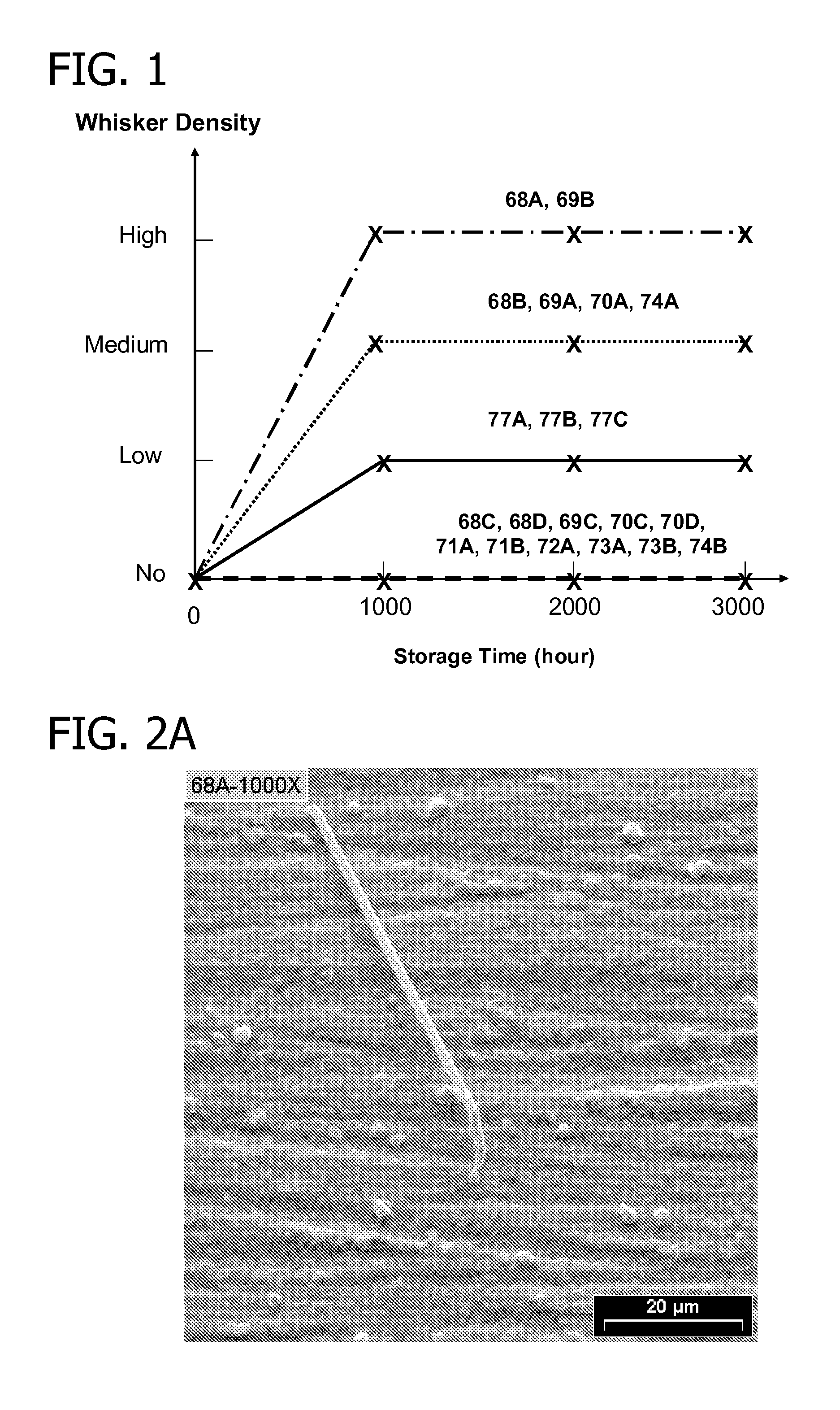Immersion tin silver plating in electronics manufacture
a technology of electronics manufacturing and immersion plating, which is applied in the direction of coatings, transportation and packaging, chemical coatings, etc., can solve the problems of major potential for catastrophic electrical short circuit failure of tin whiskers
- Summary
- Abstract
- Description
- Claims
- Application Information
AI Technical Summary
Benefits of technology
Problems solved by technology
Method used
Image
Examples
example 1
Immersion Tin Plating and Compositions
[0055]Copper coupons were prepared for and subjected to immersion tin plating for nine minutes in each of four immersion tin plating compositions designated 68A, 68B, 68C, and 68D that were prepared with varying concentrations of silver ions added. Prior to tin plating, the copper coupons were pre-dipped in a composition comprising sulfuric acid (2% concentration) at a temperature of 24° C. The immersion tin plating compositions were held at a temperature of about 70° C. during immersion tin silver plating. Each of the four immersion tin plating compositions contained the following components in the concentrations shown:
[0056]Tin Sulfate (12 g / L, to provide about 6.6 g / L of Sn2+ ions)
[0057]Sulfuric acid (concentrated, 98% solution, 40 mL / L)
[0058]Sodium hypophosphite (80 g / L)
[0059]Thiourea (80 g / L)
[0060]Polyvinyl pyrrolidone (PVP K30, 12 g / L of the solid powder; may be added as powder or as 40 mL of a 30 wt. % solution)
[0061]The four immersion ti...
example 2
Whisker Length
[0063]The maximum whisker length is another parameter often used to describe whisker propensity and risk. See B. D. Dunn, “Whisker Formations on Electronic Materials,” Circuit World; 2(4):32-40, 1976. The longest whiskers were identified on the samples during screening inspection (200× magnification) and recorded during detailed inspection (1000× magnification). FIGS. 3A, 3B, and 3C are SEM photomicrographs (1000× magnification) that show the longest whiskers at storage times 1000 hours (FIG. 3A), 2000 hours (FIG. 3B), and 3000 hours (FIG. 3C), respectively, at the fixed area for the coupon plated with Composition 68A, which showed a High whisker density. It can be seen that the “longest” whisker grew with the storage time. The risk of tin whiskering is therefore based not only on the whisker density but also on the whisker length.
example 3
Cross Sectional Analysis
[0064]The cross section of composition 68D which was whisker free after 5100 hours storage under ambient conditions was prepared by Focused Ion Beam (FIB) and examined by Energy Dispersive Spectroscopy (EDS). As shown in FIG. 4, which is a cross-sectional SEM photomicrograph of the tin coating layer deposited using composition 68D and after aging 5100 hours under ambient conditions, there are nano-size particles dispersed in the “free” tin, and the IMC layer is not uniform and displays a laminar structure within it. The atomic ratio of Sn / Cu gradually decreases in several spots vertically through the tin coating, IMC, and copper substrate, as shown in FIG. 5, which is a graphical depiction of the Sn / Cu atomic ratio. However, because the resolution of EDS was about 0.5 micrometers, which is relatively large compared to the total thickness of about 1 micrometer, and the sample was tilted 53°, this Sn / Cu ratio is only a qualitative estimation of the composition....
PUM
| Property | Measurement | Unit |
|---|---|---|
| concentration | aaaaa | aaaaa |
| concentration | aaaaa | aaaaa |
| concentration | aaaaa | aaaaa |
Abstract
Description
Claims
Application Information
 Login to View More
Login to View More - R&D
- Intellectual Property
- Life Sciences
- Materials
- Tech Scout
- Unparalleled Data Quality
- Higher Quality Content
- 60% Fewer Hallucinations
Browse by: Latest US Patents, China's latest patents, Technical Efficacy Thesaurus, Application Domain, Technology Topic, Popular Technical Reports.
© 2025 PatSnap. All rights reserved.Legal|Privacy policy|Modern Slavery Act Transparency Statement|Sitemap|About US| Contact US: help@patsnap.com



